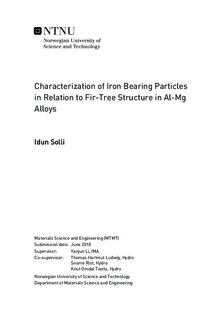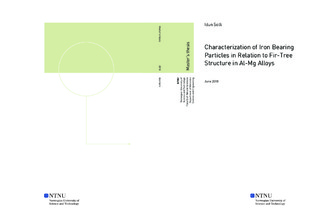| dc.description.abstract | Fir-tree structure is a well-known problem related to DC cast AA1xxx and AA5xxx alloys. During DC casting different iron bearing particles, e.g. AlmFe, Al3Fe and Al6Fe, are formed. A change of the dominating iron bearing particles across the ingot cross section can result in Fir-tree structure, which in turn will cause streaking in the anodised aluminium product. This master thesis consisted of two main parts: development of reliable experimental methods to identify different types of iron bearing particles and quantitative characterization of iron bearing particles to study the mechanism for Fir-tree structure formation.
Samples cut from the cross section of a commercial DC cast AA5005 sheet ingot was studied. Different techniques and approaches for characterization of iron bearing particles were tested and compared. The morphology of the iron bearing particles was studied in both plane polished samples, deep etched samples and in powder samples. The iron bearing particles have been identified by a combination of EBSD, WDS and XRD.
The grain size of the ingot as a function of the distance from the ingot surface has been measured by anodising and light microscopy. It shows that the grain size increases with increasing distance from the surface of ingot. This indicates that the cooling rate is highest at the surface of the ingot and decreases towards the center of the ingot. A transition in dominating morphology of iron bearing particles could be observed in light microscope imaging. At the ingot surface region until a depth of 5.6 cm, where the cooling rate is highest, the dominating particle was skeletal shaped. At regions of 7.2-10.4 cm in distance to surface, it was a mix of skeletal and needle-like particles. The dominating morphology of particles at regions of 12.0-13.6 cm in distance to surface, where the cooling rate is lowest, was needle-like.
It was shown that EBSD and WDS could not be used for quantitative analysis, but could be used to determine the characteristic morphology of the different iron bearing phases. The characteristic morphology of AlmFe was skeletal with frequently branching. Needle-like and stacked plate was the typical morphology for Al3Fe. Al6Fe was only identified with EBSD and WDS occasionally, showing the morphology was either skeletal-like or plate-like.
The phenol method for extracting iron bearing particles from the aluminium matrix, was for the first time developed at the Department of Materials Science and Engineering. The iron bearing particles were successfully extracted, and a quantitative analysis of the particle powder XRD results were performed by the Rietveld refinement method. The measured fraction of different phases showed that AlmFe dominated the regions close to the ingot surface, with approximately 90 wt%. The remaining particles were Al3Fe. At 135 mm in distance to surface, the phase distribution of particles was completely different: 89 wt% Al3Fe, 10 wt% AlmFe and 1 wt% Al6Fe. Al6Fe phase only existed as a minority phase at some locations towards the center of the ingot.
Between 65 and 79 mm in mean distance to surface, there was a rapid change in dominating particle phase from AlmFe to Al3Fe. This corresponds well with the measured minimum Fir-tree height of 59 mm and the morphology study. The reason for the formation of Fir-tree structure, was supposed to be the sudden change of dominating iron bearing phases. The phase selection of iron bearing particles was distribution was discussed inn correlation with local cooling rate in the ingot during solidification and chemical composition of the alloy. | |

